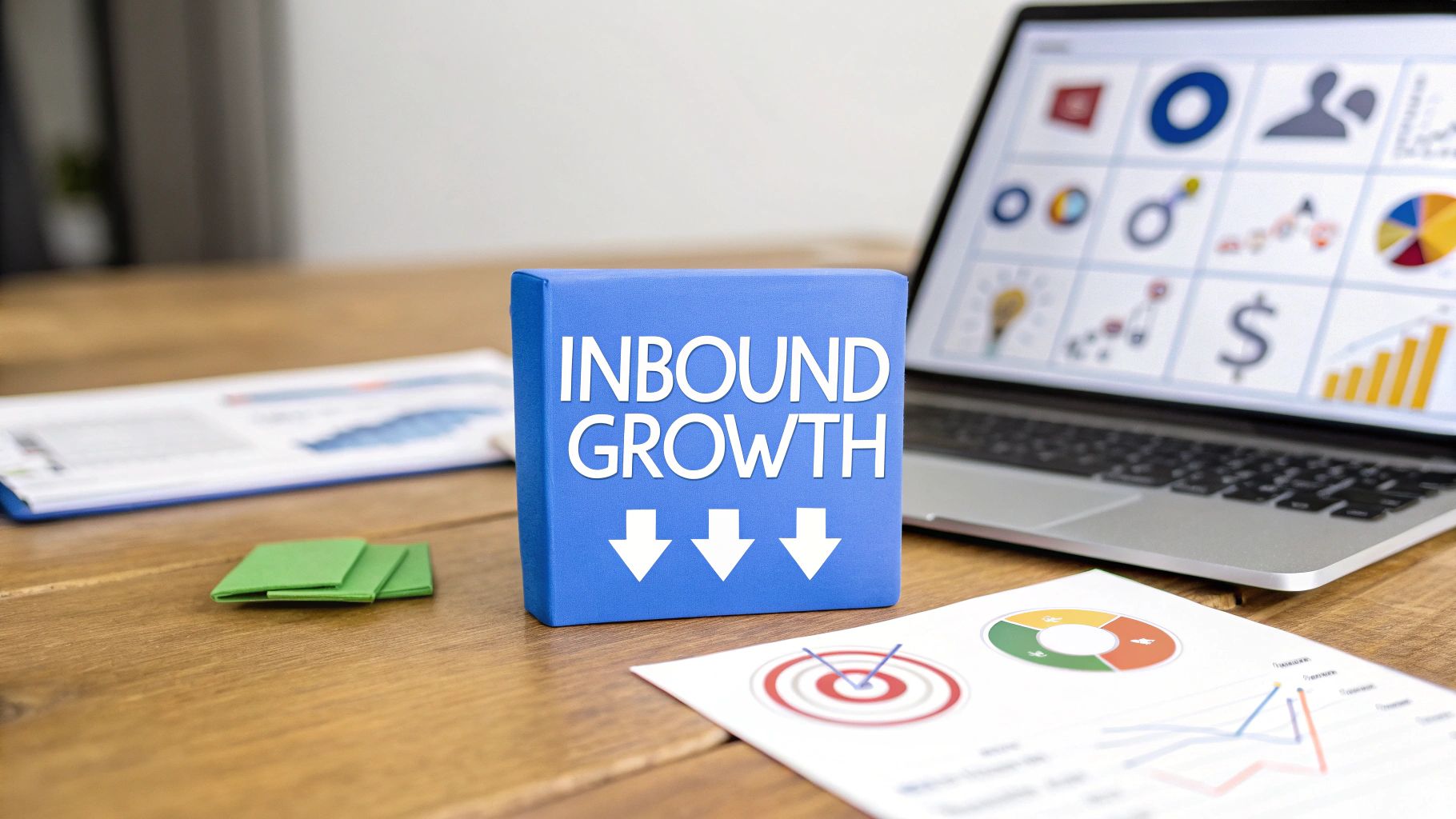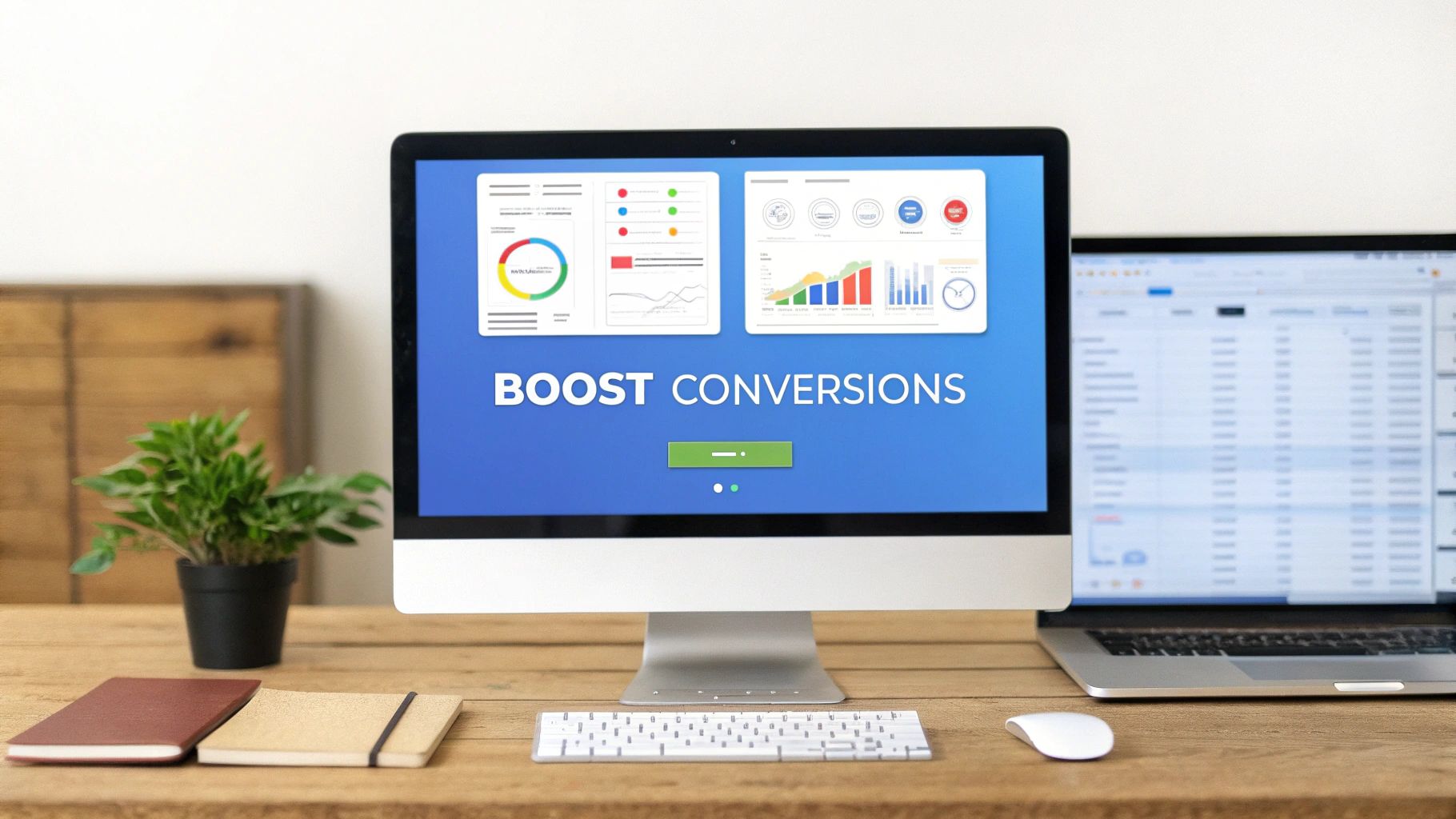Summary
Meta Description: Discover how to create high-converting real estate landing pages. This guide covers essential elements, proven strategies, and examples to turn clicks into clients.
So, what exactly is a real estate landing page? Think of it as a standalone webpage built for one specific marketing goal, like capturing a lead for a particular property or offering a free home valuation. Unlike your main website, which is full of different navigation options, a landing page is laser-focused on one single call to action. This focus is what makes it so incredibly effective at turning visitors into clients.
Ready to transform your lead generation? Let's dive in.
Why Landing Pages Are Your Secret Weapon in Real Estate
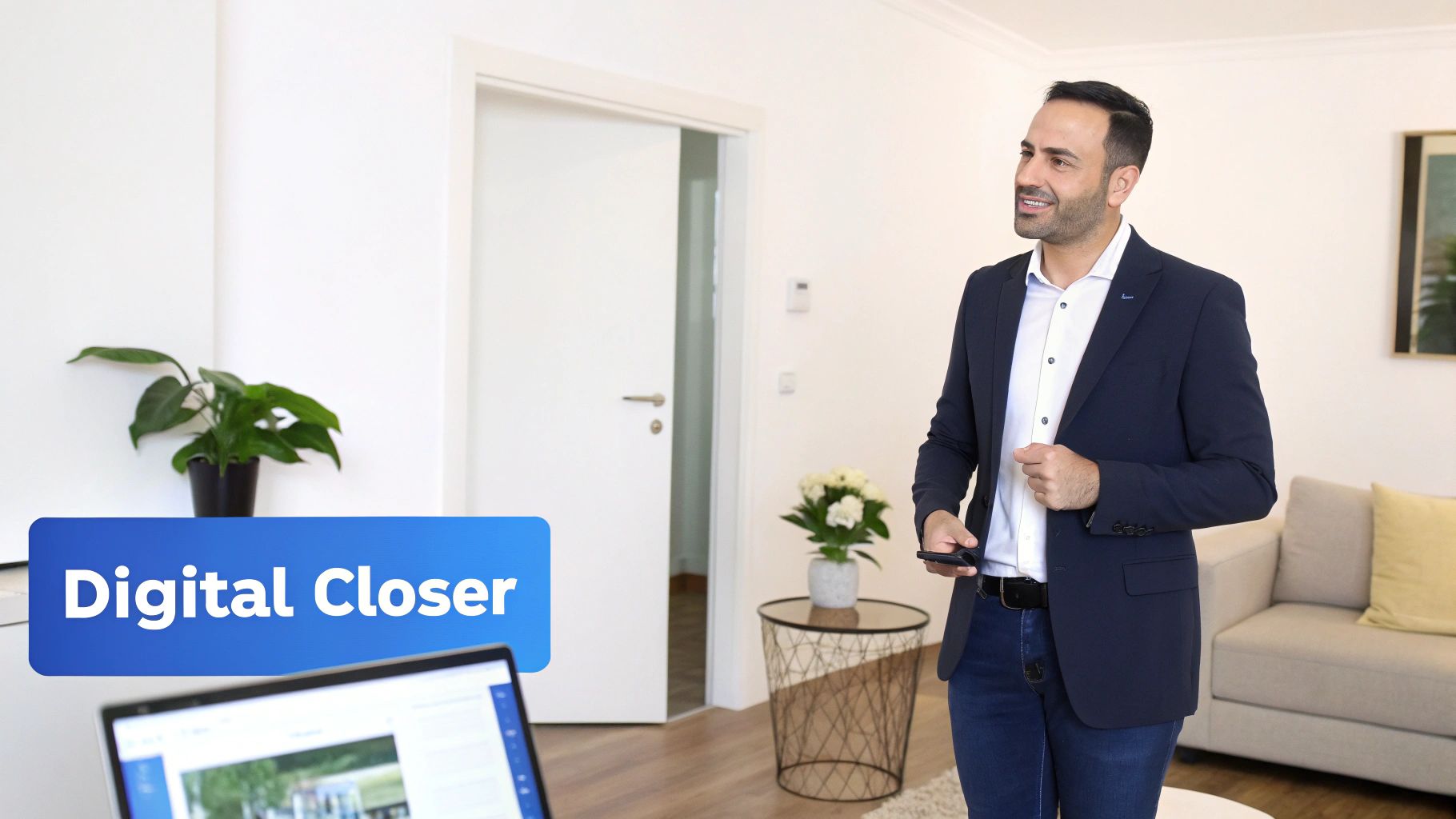
Imagine your main real estate website is a bustling open house. Visitors can wander from room to room (your pages), check out various listings, read your bio, or browse neighborhood guides. It’s a great place for general exploring, but it's also packed with distractions.
A real estate landing page, on the other hand, is like a private showing. It’s a direct, one-on-one conversation with a potential client about a single offer. Every single element on that page—from the headline and images to the copy—is designed to guide the visitor toward one clear action.
The Power of a Single Goal
The real magic of a real estate landing page lies in its simplicity. By stripping away all the extras—like site navigation, blog links, or multiple property listings—you create an uncluttered, direct path for the user. This singular focus is precisely why they are so effective at turning marketing dollars into real, measurable results.
What can a well-designed landing page do for you?
- Generate Qualified Leads: By offering something valuable, like a free home valuation report or a downloadable buyer's guide, you capture contact details from people who are genuinely interested.
- Promote Specific Properties: A dedicated page for a hot new listing can showcase high-quality photos, a virtual tour, and key details far more powerfully than a standard MLS listing ever could.
- Drive Event Sign-Ups: Looking to fill your next open house or webinar? Direct all your promotional traffic to a simple sign-up page and watch the RSVPs roll in.
A landing page is your digital closer. It doesn't just present information; it's engineered to persuade a visitor to take the next logical step in their real estate journey.
To really nail this down, it helps to see how a landing page's role differs from your main website.
Landing Page vs. Website: What's the Difference for Real Estate Agents?
While both are critical digital assets, they serve very different purposes. Your main website is your digital storefront, meant for exploration and brand building. A landing page is your specialist salesperson, focused on closing one specific deal.
This table breaks down the key differences:
Understanding this distinction is key. You don't send targeted ad traffic to your homepage and hope for the best; you send it to a dedicated landing page designed to convert.
Higher Conversions by Design
This focused approach delivers real, tangible results. Real estate landing pages consistently show higher conversion rates than general real estate websites. While the average conversion rate is around 7.4%, the median sits at a more grounded 2.6%. What does that tell us? While many pages perform adequately, a truly well-optimized page can produce exceptional outcomes. You can dig into more performance stats on landingi.com.
Ultimately, by creating these specialized pages, you build a powerful system for turning online traffic into actionable leads. They're an indispensable tool for any agent serious about growing their business.
The Anatomy of a High-Converting Real Estate Landing Page
Ever wonder what separates a real estate landing page that gets ignored from one that generates a constant stream of leads? It’s not luck. It's a deliberate combination of proven elements, all working together in perfect harmony.
A high-converting page is like a perfectly staged home—every piece has a purpose, guiding the visitor toward a single, desirable outcome. Let's break down the essential components that every successful real estate landing page shares. Consider this your blueprint for turning clicks into clients.
Craft an Irresistible Headline
Your headline is the first thing a visitor reads. It has one job: grab their attention and convince them to keep scrolling. A powerful headline needs to be benefit-driven, crystal clear, and directly connected to the ad or link that brought them there.
Forget generic titles like "Find Your Dream Home." Get specific and speak directly to what your visitor wants.
- For Sellers: "Discover Your Home's True Value in Under 60 Seconds"
- For Buyers: "Get Exclusive Access to Off-Market Listings in Downtown Austin"
- For a Specific Property: "Experience Luxury Living at 123 Ocean View Drive"
This immediate clarity tells visitors they’re in the right place and that you have the solution they’re looking for.
Use Compelling Visuals That Tell a Story
Real estate is a visual business. Your landing page must feature high-quality, professional photos or videos that pack an emotional punch. Grainy, poorly lit images will kill your credibility in a heartbeat.
Your goal here is to help visitors feel what it's like to be in the space. Use stunning imagery that showcases the property's best features—a sleek modern kitchen, a sun-drenched living room, or a jaw-dropping view. For a specific listing, a professionally shot video tour can be a game-changer, keeping people engaged on your page for longer.
Visuals aren't just decoration; they are the emotional engine of your landing page. They should make a potential client feel an immediate connection to the property or the value you're offering.
That emotional connection is what turns a casual browser into a motivated lead.
Write Persuasive Copy That Speaks to Your Audience
Once your headline and visuals have done their job, your copy needs to seal the deal. This is where you speak directly to your audience's hopes, fears, and questions. Good copy is concise, easy to scan, and always focused on the benefits, not just the features.
Use short paragraphs and bullet points to make key information pop. For instance, instead of just listing "3 bedrooms, 2 baths," frame it as a solution to their needs:
- Room for the Whole Family: Three spacious bedrooms provide comfort and privacy for everyone.
- A Spa-Like Retreat: Unwind in your master suite with a luxurious, fully renovated ensuite bathroom.
- Effortless Entertaining: An open-concept living area flows seamlessly into a modern, chef-inspired kitchen.
When you address what your ideal client truly wants, you build a much stronger connection and make your offer irresistible.
Build Instant Trust with Social Proof
Why should a stranger trust you with what might be their biggest financial decision? This is where social proof comes in. Including testimonials, reviews, or recent success stories provides crucial third-party validation that eases a potential client's anxieties.
A short, impactful quote from a happy client can be more persuasive than anything you could ever write about yourself.
"Working with [Your Name] was the best decision we made. They helped us find our perfect home and made the entire process stress-free." – The Smith Family
Pro tip: adding a client's photo next to their testimonial makes it feel even more authentic and trustworthy.
Create a Clear and Compelling Call to Action (CTA)
This is the most critical part. Every single element on your page—the headline, photos, and copy—should funnel the visitor toward one thing: the call to action (CTA). This is the button or form that prompts them to take that next step. Your CTA has to be impossible to miss and crystal clear.
Use action-oriented, specific language. Ditch the vague "Submit" button and use text that reinforces the value they're about to receive:
- "Get My Free Home Valuation"
- "Schedule My Private Tour"
- "Download the Buyer's Guide Now"
Keep the form itself dead simple. Only ask for the information you absolutely need. Every extra field you add can tank your conversion rate. A name and an email or phone number is often all it takes to get the conversation started.
Essential Landing Page Blueprints for Real Estate Success
A one-size-fits-all website just doesn't cut it in real estate. The same goes for your digital marketing. You have different conversations with a first-time buyer than you do with someone thinking about selling their home. This is where strategic real estate landing pages become your secret weapon—they're specialized blueprints designed to meet potential clients exactly where they are.
Instead of funneling everyone to your generic homepage, you can create tailored experiences for sellers, buyers, and everyone in between. By matching the page to what the visitor is looking for, you dramatically increase the chances of turning a casual click into a genuine connection.
Home Valuation Pages for Motivated Sellers
The question "What's my home worth?" is a powerful magnet for homeowners who are starting to think about selling. A home valuation landing page is built to do one thing: answer that question. It's one of the most effective tools for generating seller leads.
The goal is simple. You offer an instant, automated property value estimate in exchange for the homeowner's address and contact information.
- Target Audience: Homeowners in the early-to-mid stages of considering a sale. They're curious about their equity and what their home could fetch in today's market.
- Critical Elements: You need a bold, can't-miss headline like "Find Out Your Home's True Value in 60 Seconds." Pair that with a simple address input field and a clear call-to-action (CTA) button that says something like, "Get My Free Report." The key is to keep the form short and sweet to maximize submissions.
Single Property Pages to Dazzle Buyers
When you land a standout listing, it deserves its own spotlight. Think of a single property landing page as a dedicated microsite designed to showcase one specific home in stunning detail, going far beyond what a standard MLS listing can do.
This page is all about creating an immersive, emotional experience that makes a buyer fall in love before they even step through the front door.
- Target Audience: Active buyers who've clicked on an ad, email, or social media post about a specific property they're interested in.
- Critical Elements: This blueprint lives and dies by its visuals. We're talking a professional photo gallery, a cinematic video tour, and even an interactive 3D walkthrough. Add compelling property descriptions, a downloadable floor plan, and a prominent CTA to "Schedule a Private Tour."
Open House Sign-Up Pages to Fill Your Events
An open house is a fantastic way to meet potential buyers, but only if people show up. An open house sign-up page is a simple, event-focused tool built to capture RSVPs and build buzz.
This page acts as a central hub for all the event details and makes registration completely painless, helping you gauge interest and follow up with everyone who plans to attend.
No matter which type of page you're building, the core structure for conversions remains the same.
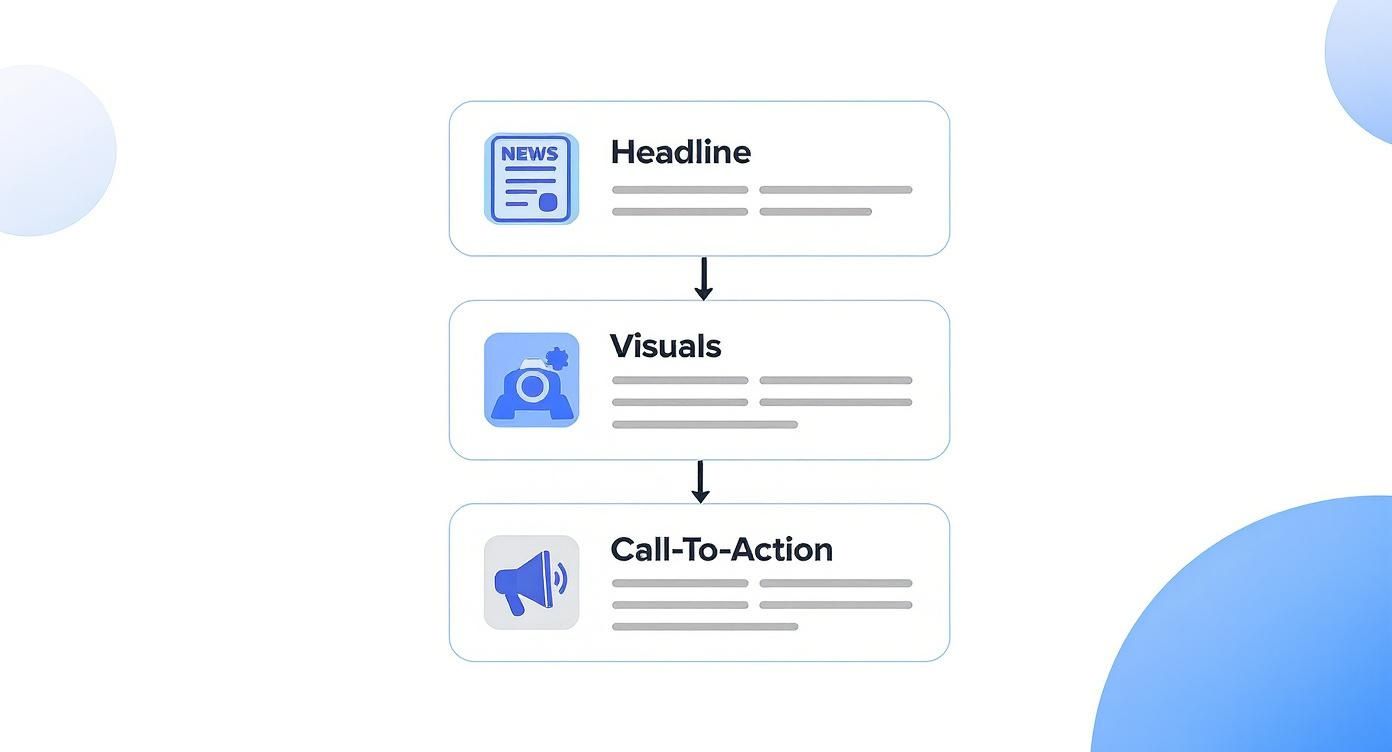
This simple hierarchy shows that every great page starts with a killer headline to grab attention. Then, you use engaging visuals to create desire, and finally, you seal the deal with a clear call-to-action that tells them exactly what to do next.
Exclusive Content Pages to Nurture Leads
Not everyone is ready to buy or sell today. An exclusive content landing page is your tool for capturing leads much earlier in their journey by offering something genuinely valuable in exchange for their contact info. This is how you build your pipeline for the long haul.
Think of this as offering a helpful resource, not a sales pitch. Your goal is to establish yourself as the go-to local expert they can trust.
What kind of content works best?
- A downloadable "First-Time Home Buyer's Guide."
- A "Neighborhood Market Report" for a specific zip code.
- A handy checklist for "Preparing Your Home for Sale."
The CTA should mirror the offer, like "Download Your Free Guide." This strategy positions you as a knowledgeable advisor, building trust with people who will remember you when they are ready to make a move.
Proven Strategies to Optimize Your Real Estate Landing Pages
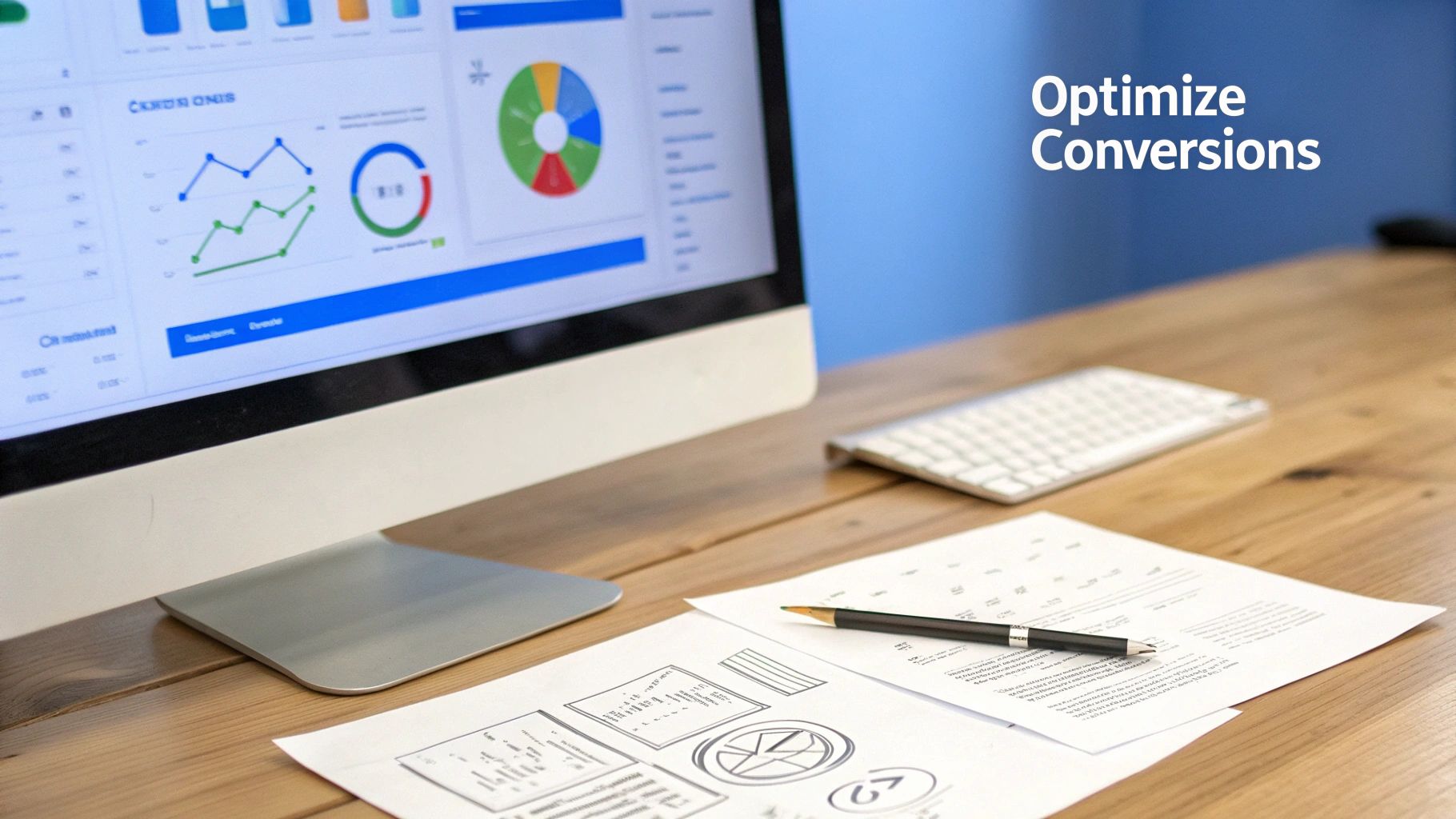
Getting your real estate landing pages live is a huge first step, but the real work starts after you hit "publish." Think of it like listing a home—you don't just put up a "For Sale" sign and hope for the best. The magic is in the refinement, those continuous tweaks that turn a good page into a lead-generating powerhouse.
This is where you shift from building to optimizing. By using a few practical, data-driven techniques, you can seriously boost the number of leads your pages bring in. Let’s dive into the strategies that will transform your digital storefront.
Make Every Second Count With Faster Page Speed
In real estate, timing is everything. It's the same with your landing page's load speed. If a potential client clicks your ad and has to wait for images and text to load, they’re not sticking around. They’ll just hit the back button and head straight to your competitor.
Slow speed is a conversion killer. Every extra second of load time can cause a major drop in leads. You need to ensure your images are compressed, your code is clean, and your hosting is up to snuff.
Your page's performance is a direct reflection of your professionalism. A fast, seamless experience tells visitors you value their time and pay attention to the details.
This isn't just a friendly suggestion; it has a real, measurable impact on your bottom line. Research has shown that pages loading in under one second can see conversion rates as high as 31.79%. Making speed a top priority is non-negotiable if you want more leads.
Design Frictionless Forms for More Submissions
Your lead capture form is the final hurdle between a curious visitor and a new lead. If it's too long, confusing, or asks for too much, people will bail. The secret to a great form is to ask for as little information as possible.
Every single field you add creates more friction. Do you really need their full address right now? Or is a name and email enough to start the conversation?
Studies consistently show that shorter forms get better results. Forms with five or fewer fields usually have the highest submission rates because they feel less intimidating and take just a few seconds to complete.
Find What Works with A/B Testing Your Landing Page Elements
How do you know if a green "Schedule a Tour" button would work better than a blue one? Or if the headline "Find Your Dream Home" connects more than "Get Exclusive Access to New Listings"? Simple: you test it.
A/B testing, or split testing, involves comparing two versions of your landing page to see which one performs better. You show version A to half your audience and version B to the other half. The one that gets more conversions is your winner.
What should you test on your landing pages?
- Headlines and Subheadings: See which message truly resonates with your audience.
- Call-to-Action (CTA) Text: Try phrases like "Get My Valuation" vs. "See My Home's Worth."
- Button Colors and Sizes: Find out which visual cues encourage more clicks.
- Images and Videos: Test different property photos or video tours to see what grabs attention.
This process takes the guesswork out of optimization. To master it, check out our complete guide on A/B testing for landing pages. Small changes can often lead to big jumps in your lead generation. For a more automated approach, exploring how chatbots for real estate can handle inquiries can also give you a serious edge.
How to Drive High-Quality Traffic to Your Landing Pages
A perfectly designed landing page is like a beautifully staged open house—it’s impressive, but completely useless if nobody shows up. Getting the right people to your digital doorstep is the critical next step, and it takes a smart, targeted approach to make it happen.
Think of traffic generation as handing out personalized invitations. You wouldn't just stand on a random street corner yelling about a property. Instead, you'd go where your ideal clients are already hanging out. In real estate, this means tapping into paid ads, email marketing, and organic search to fill your pipeline with genuinely interested leads.
Reaching Ideal Clients with Social Media Ads
Platforms like Facebook and Instagram are goldmines for real estate agents because their targeting capabilities are incredibly precise. You can build ad campaigns that zero in on people based on their location, income level, major life events (like getting married or having a baby), and online interests.
Imagine you have a landing page for a new family-friendly listing. You can run an ad that is only shown to people in your target zip codes who have young children and have recently shown interest in sites like Zillow.
Here's how to make it work:
- Match the Ad to the Page: The promise you make in your ad must perfectly align with the experience on your landing page. If your ad features a luxury condo, the page it links to better not be about a starter home.
- Use Compelling Visuals: Video is king on social media. A short, captivating video tour of the property will stop scrollers in their tracks far more effectively than a static photo.
- Have a Crystal-Clear Call to Action: Your ad needs to tell people exactly what you want them to do next. Use phrases like "Learn More" or "Get Instant Access," and link them straight to your high-converting page.
Capturing Active Searchers with Google Ads
While social media helps you find potential clients, Google Ads helps clients who are actively looking for you find you first. When someone types "homes for sale in [your city]" into Google, you can place your landing page right at the top of their search results.
This is an incredibly powerful strategy because you're connecting with people who have high intent. They have a specific need, and you're offering the immediate solution.
For real estate professionals, Google Ads is a direct line to motivated buyers and sellers. The key to success is pairing a highly relevant ad with a landing page that seamlessly continues the conversation.
To squeeze the most out of your ad spend, create a cohesive journey from ad click to conversion. For example, if someone clicks an ad about properties in a specific neighborhood, dynamically adjust your page to reflect that location. Learn how to insert dynamic location details on a Google Ads landing page for next-level personalization.
Attracting Organic Traffic With On-Page SEO
Paid ads get you results fast, but search engine optimization (SEO) is your long game for a free, sustainable stream of traffic. By optimizing your landing pages with the right keywords, you can attract people who are searching for real estate solutions organically.
Start by putting yourself in your clients' shoes. What are they typing into Google? They might search for phrases like "best real estate agents in [your town]" or "downtown condo listings." Weave these long-tail keywords naturally into your headlines, subheadings, and body copy.
A solid grasp of SEO for real estate is crucial for climbing the ranks in local search results.
Nurturing Leads with Email Marketing
Don't neglect the leads you've already earned. Your email list is a valuable asset packed with potential clients who have already shown interest.
Sending targeted emails that link back to your specialized landing pages is a fantastic way to re-engage them. You could send a "just listed" email blast that directs subscribers to a single property page, or a newsletter that links to your latest market report landing page. This keeps you top-of-mind and drives high-quality traffic from a warm, receptive audience.
Real-World Examples of Winning Landing Pages
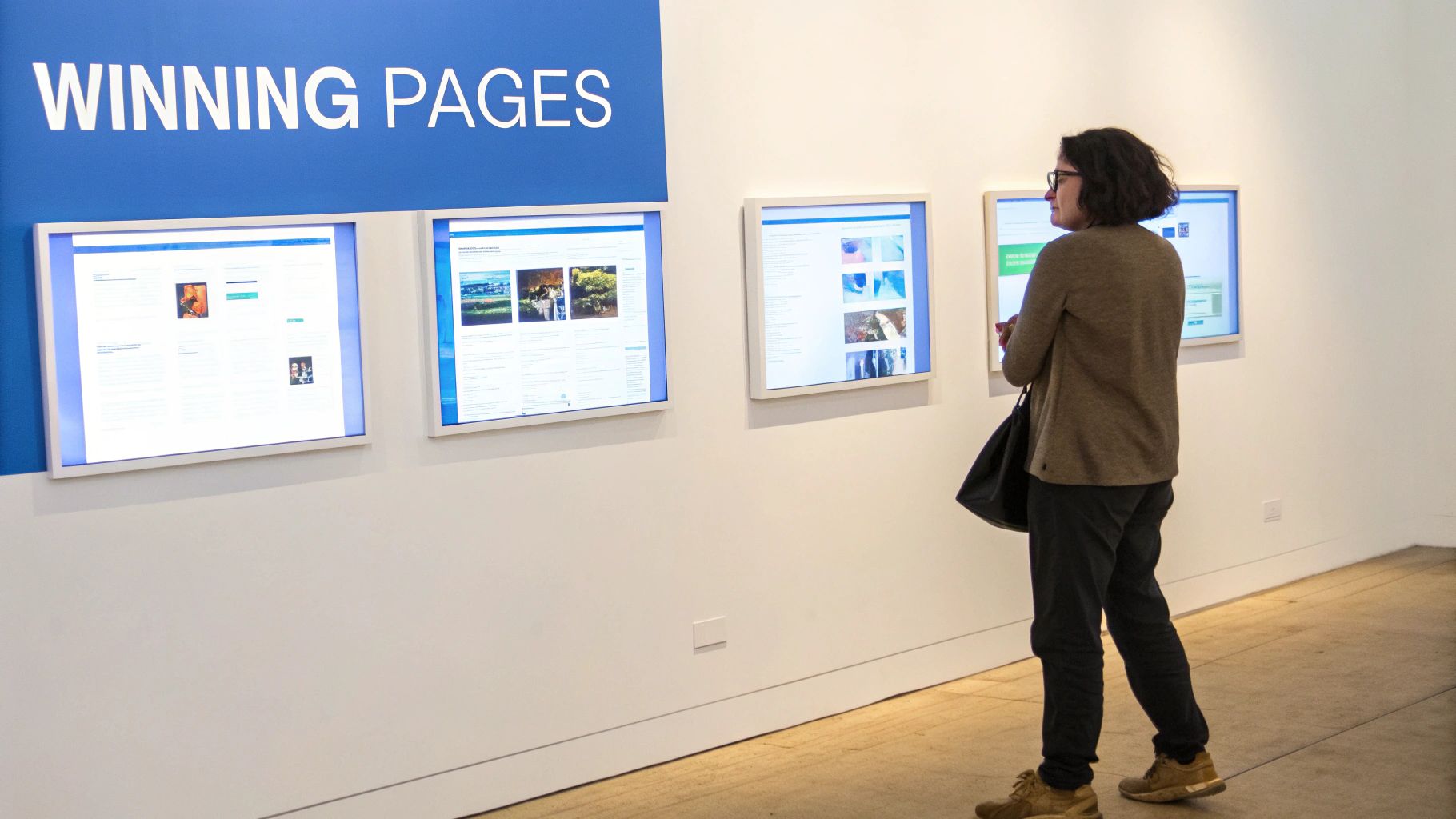
Theory is great, but seeing what’s actually working is where the real learning happens. To connect the dots between best practices and real-world results, let's pull back the curtain on a few winning real estate landing pages.
We'll break down exactly what makes them so good at turning casual visitors into solid leads. Think of these as mini case studies—you'll see the principles we've discussed in action and get tangible inspiration for your own pages.
Example 1: The Sleek Home Valuation Tool
One of the oldest tricks in the book is still one of the best: the free, instant home valuation. These pages are lead-generating powerhouses for a reason. They usually feature a bold, can't-miss headline like, "What's Your Home Really Worth?"
Why do they convert so well?
- Simplicity and Focus: The entire page has one job. There's no navigation bar or other links to distract the visitor—just a simple form asking for a property address.
- Clear Value Proposition: The benefit is immediate and incredibly compelling. You know exactly what you're getting in exchange for your information.
- Frictionless Form: The initial ask is tiny, usually just the address. This low-commitment first step hooks users before they're asked for their name and email.
This type of page taps directly into the number one question on any potential seller's mind, making it an insanely reliable way to generate leads.
Example 2: The Stunning Single Property Showcase
When you're marketing a special listing, a dedicated landing page can create an immersive experience that a standard MLS sheet can't touch. Picture a page for a luxury home that greets you with a breathtaking, full-screen video tour the second it loads.
This strategy captivates buyers by focusing their attention on building an emotional bond with one specific home. The headline could be as simple as the address itself, like, "Experience Unmatched Luxury at 123 Seaside Drive."
By dedicating an entire page to one property, you elevate its status. You're not just showing a house; you're presenting a unique opportunity that demands a visitor's full attention.
These pages are all about visuals—professional photos, virtual tours, and dramatic drone footage—paired with a clear call-to-action like "Schedule a Private Showing." It’s designed to turn passive browsing into an active step toward a sale. For more ideas on tailoring pages to specific audiences, check out these personalized landing page examples.
Example 3: The Compelling New Development Showcase
A landing page is the perfect tool for capturing interest in a new condo development or subdivision long before the first foundation is poured. These pages thrive on anticipation, often showcasing architectural renderings, a list of future amenities, and an air of exclusivity.
Here, the primary goal is building a VIP list of interested buyers. The call-to-action is usually something like, "Join the VIP List for Exclusive Updates" or "Register for Pre-Sale Pricing." This strategy builds hype while filtering for highly motivated leads who want to be first in line.
While the conversion rates for real estate landing pages can vary, a well-executed page will blow the industry average of 2.4% out of the water. As Unbounce's latest report points out, top-performing pages can easily break 5% by perfectly matching the offer to the audience's needs.
Your Top Questions About Real Estate Landing Pages Answered
Jumping into the world of real estate landing pages always brings up a few questions. From budget worries to feeling like you're not "techy" enough, plenty of agents pump the brakes before they even get started.
Let's clear the air. This section will tackle the most common hurdles with real, straightforward answers. Think of it as your go-to FAQ for turning hesitation into action.
How Much Does a Landing Page Cost to Build?
The price tag can swing wildly, but you absolutely don't need to break the bank. What are your options?
- The DIY Route: This is the most popular choice. Platforms like LanderMagic, Leadpages, or Instapage give you pro-level templates for a monthly subscription, usually starting in the $50-$100 range. You get full control without the custom-build price.
- Hiring a Freelancer: If you want something custom but don't want to do it yourself, a good freelance designer might charge anywhere from $300 to $1,500 for a single, well-designed landing page.
- Going with an Agency: For the full package—strategy, design, copywriting, and ad management—an agency is your best bet. This is a bigger investment, often in the $2,000 to $5,000+ ballpark.
Ultimately, the right choice depends on your budget and how hands-on you want to be.
Do I Need to Be a Tech Whiz to Build One?
Not at all. Modern landing page builders were created for marketers and business owners, not coders. They use simple drag-and-drop editors that feel more like making a PowerPoint slide than building a website.
If you can put together a social media post or design a property flyer in Canva, you have all the technical skills you need to build a beautiful, professional landing page. The barrier to entry has never been lower.
Plus, these platforms are packed with tutorials and have support teams ready to help if you get stuck. You can genuinely have a page live in an afternoon without ever looking at a line of code.
How Many Landing Pages Do I Actually Need?
There’s no magic number, but here’s a rule of thumb: more is better. In fact, businesses see a 55% increase in leads when they go from having 10 landing pages to 15.
But don't get overwhelmed. Just start small.
Create one dedicated page for a specific listing you're promoting. Then, create another one for a "What's My Home Worth?" offer. Once you get the hang of it, you can create pages for different neighborhoods, buyer guides, or property types. The goal is to eventually have a unique landing page for every marketing campaign you run.
Ready to build high-converting pages without the technical headaches? LanderMagic gives you the tools to build dynamic, personalized real estate landing pages in minutes. Start building for free and turn more clicks into clients today!




